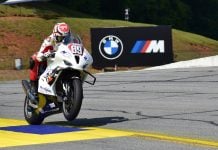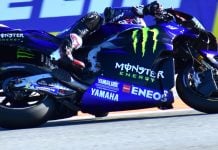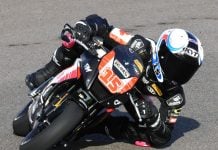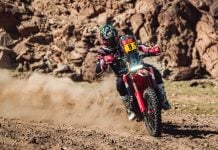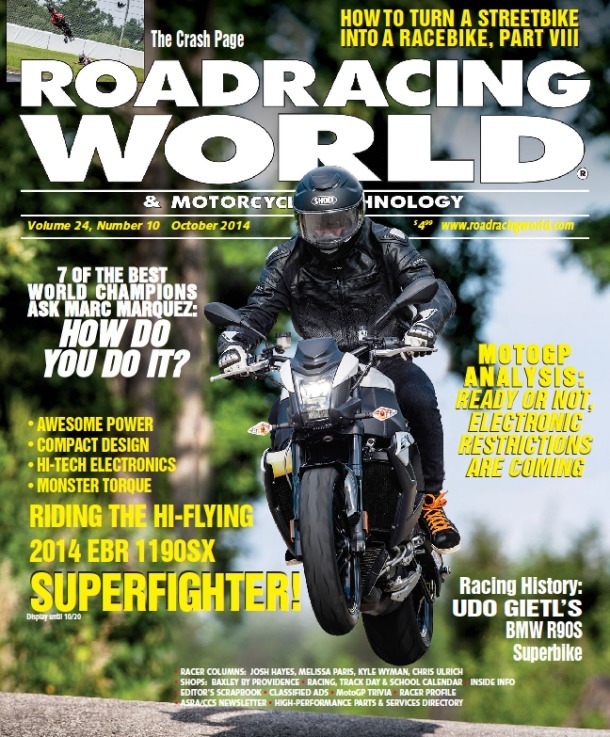To read more articles like this test featured in the October 2014 print issue, please subscribe to Roadracing World.
2014 EBR 1190SX Intro EAST TROY, WISCONSIN
Sportbike Power And Electronics In A Superfighter Package
By John Ulrich
Everything you need to know about the new EBR 11090SX starts with torque. Waves of torque so broad and strong that the EBR 1190SX accelerates hard from just past 4000 rpm and can be hustled down a twisty public road without ever topping 6000 rpm. Peak torque of 101.6 lbs.-ft. comes at 8200 rpm but the engine produces no less than 80 lbs.-ft. (about 80% of peak) across a range of 7000 rpm, from about 4500 rpm to redline at 11,500 rpm.
Call it a torque monster, but it also makes a claimed 185 peak horsepower at 10,600 rpm, calculated at the crankshaft. No wonder. This isn’t a motorcycle built around an obsolete or detuned engine and labeled a “streetfighter.” This motorcycle is basically an EBR 1190RX – a machine company founder Erik Buell calls a superbike instead of a sportbike – without the fairing and clip-on handlebars.
The 1190SX has the same chassis and the same engine as the 1190RX, with tapered, tubular aluminum-alloy handlebars bolted to the upper triple clamp replacing the RX model’s clip-on bars, along with minimalist body panels and a headlight/instrument module replacing the RX’s full bodywork and associated brackets. The 1190SX’s bars are taller and wider, the claimed wet weight a little less, the weight distribution a little different, the overall width a little narrower and the suggested retail price $2000 lower.
But the SX comes with the same advanced electronics as the RX and makes the same power and torque. Which is why former racer Erik Buell suggests that the appropriate description for his new company’s first unfaired streetbike is “superfighter” instead of streetfighter. And true to the company founder’s vision, EBR’s promotional material calls the 1190SX “”a genuine high-performance motorcycle with a racing heritage…designed to be a dominating street machine.”

The introduction of the EBR 1190SX is the latest chapter in Erik Buell’s rebirth as a motorcycle manufacturer. He founded and built up Buell Motorcycle Company over a period of decades, eventually selling the company to Harley-Davidson and staying on as an employee. But then the economy tanked and motorcycle sales dove. Harley-Davidson reacted by closing down its Buell Motorcycle Company subsidiary in East Troy, Wisconsin at the end of 2009, getting rid of the Buell factory and its production line fixtures, and laying off most of the employees (a few engineers were put to work at Harley-Davidson itself). Harley-Davidson kept the rights to build motorcycles labeled with Erik Buell’s surname-along with other trademarks-but in the face of a public outcry agreed to let Erik Buell start Erik Buell Racing (or EBR) and sell leftover Buell engines and performance parts to racers. From that humble restart, Erik Buell has rebuilt his company step by step, aided by outside investors including Hero Moto-Corp Ltd. of India, (the largest motorcycle manufacturer in the world by unit volume), which bought 49.2% of EBR for $25 million in 2013. The investment fueled growth for EBR as well as for EBR Engineering Services, an affiliated company which does engineering work under contract for Hero and other motorcycle manufacturers.
Along the way, Erik Buell moved back into the factory building (formerly occupied by the Harley-Davidson subsidiary) on Buell Road, rebuilt his manufacturing infrastructure and started hiring the people needed to design, prototype, develop, test, build and sell motorcycles. His work force has gone from 13 in 2011 to about 150 currently, with about 100 working in engineering or handling business functions and another 50 working on engine and motorcycle assembly lines or otherwise supporting the physical production of motorcycles.
One very important move Erik Buell made while rebuilding his company was buying the design, tooling and vendor-access rights to what was the Buell 1125R engine built by Rotax to Buell Motorcycle Company specifications. About 80% of that engine was repurposed into the EBR 1190RS engine, with obvious changes being related to the increase in displacement. By the time 1190RS production was up and running, EBR engineers were already at work on what would become the 1190RX and 1190SX engine, increasing power production, throttle response and fuel efficiency while also decreasing emissions by concentrating on improving combustion efficiency.

A key factor in that successful work was development of EBR Controlled Swirl Induction. At small throttle openings, the system blasts clean air from the airbox through a small, angled bypass in the intake port (below the throttle butterfly valve), past one intake valve and into the combustion chamber, swirling the incoming fuel/air mixture. At larger throttle openings the volume of air entering through the bypass port is too small (compared to the amount of air entering past the throttle plate) to induce enough swirl in the combustion chamber. Thus the intake cam lobes are shaped so one intake valve opens before the other, creating more swirl. (The delayed-opening cam lobe catches up to the other lobe so both intake valves reach peak opening-and also close-at the same time.) The swirl helps pack more fuel-air mixture into the cylinder and makes that mixture more homogenous. Which helps the mixture burn more completely-in other words, maximizing combustion efficiency.
During the recent introduction of the 1190SX at EBR headquarters, I got the feeling that people who work at EBR are there because they want to be. Some, like 1190RX and 1190SX Program Manager Dane Hoechst, were Harley-Davidson engineers assigned to Buell Motorcycle Company when it was a subsidiary; when Buell was closed down, Hoechst was kept on by Harley-Davidson and worked on various new Harley-Davidson models. But as EBR rose from the ashes of Buell Motorcycle Company, Hoechst-who told me he personally owns two Buell motorcycles-applied for a job. After three years in exile at Harley-Davidson headquarters, Hoechst is back working for Erik Buell. Hoechst told me that working at EBR is fun, and a lot different than working for Harley-Davidson Motor Co.
Word must have gotten out that EBR is no ordinary company, because it attracts applicants from around the world. It seems typical that Erik Buell has developed a process to try to identify talent instead of just looking at the experience a given applicant has. (Although experience must not be completely overlooked in favor of perceived talent, since the company points out that its employees have a combined 577 years of motorcycle design experience.) The process takes three hours and includes meeting with three interview groups and taking four tests. The goal is to find people who can innovate and think on their feet, and the process has led to EBR hiring people from Denmark, Germany, Japan and Spain as well as from the U.S. (At any given moment several Hero MotoCorp engineers from India are also likely to be on-site or off testing with EBR engineers, as part of EBR Engineering Services’ design and technology support relationship with Hero MotoCorp, which predated-and helped lead to-Hero investing in EBR.)

Racers are among those hired by EBR; the company says that 12 of its employees have won championships and 16 have won races. This is not surprising to me, because Erik Buell raced for decades and is still a racer at heart. He knows that people who have successfully raced motorcycles or worked in successful racing programs usually have an acute understanding of the importance of getting things done on time. Because let’s face it, if you or your bike aren’t on the grid when the race starts, nobody is going to wait. In manufacturing, the design and prototype and regulatory approval work all has to be done in time to order the parts and set up the factory to build the bike and get it to dealers in time for the new selling season.
So, if you want something done on time, there are advantages to working with successful racers. Beyond that, Erik Buell loves racing. I am convinced that if he built refrigerators for a living, he’d find some way to race them!
The EBR factory in East Troy assembles motorcycles from outsourced parts. There isn’t any fabrication going on in the factory. The 1190RX, for example, has 663 unique components produced by 157 suppliers from 13 countries. (The numbers for the 1190SX were not supplied but should be similar given the common engine and chassis parts shared by the RX and SX.)
The frame and integrated 17-liter (4.5-gallon) fuel tank assembly comes from a supplier in a suburb of Chicago. The combination frame and fuel tank is built by welding together castings and stampings made from a special high-elongation aluminum-alloy; the interior of the fuel-carrying sections are coated with a special epoxy and the assembly is designed to produce a specific lateral rigidity. Once it arrives at EBR, each assembly is fitted with a fuel pump, bolted to a fixture over a water tank and pumped full of compressed air through a special filler-neck plug. The pressurized frame is then dunked under water and a worker looks for any leaks. So far, the company says none of the frame/tank assemblies themselves have leaked. A few leaks have been detected where the fuel pump or gas cap ring bolt on, the problem corrected by reinstalling the component before a re-test.
Each piece of bodywork is molded-using heat and pressure-from a laminated polymer sheet that incorporates base, finish, clear UV and clear anti-scratch layers. It’s produced by a racing bodywork company based in Southern California.
The intake manifold features an internal shape that maximizes air flow and was developed using computer simulation. It’s made in northwestern Wisconsin by a company that has the advanced soluble-core molding technology needed to accurately reproduce the intended shape.
The ECU and its operating system were developed through collaboration with a software partner in northern Indiana and a manufacturing partner in southeastern Wisconsin. The instrument cluster is also made in southeastern Wisconsin, as are the Hayes rear brake caliper and master cylinder. Engine components-including crankcase sets, cylinder heads, the crankshaft, camshafts, pistons, connecting rods and transmission gearsets-are all sourced in Europe, with parts coming from Germany, Austria and Italy. The titanium valves are made by U. S.-based Del West and the engine oil is made by Wisconsin-based Amsoil.
Air filters come from California-based K&N, forks and shocks are made in Japan by Showa, front brake components come from Nissin in Japan and tires are made by Italy-based Pirelli. And of course there are myriad other suppliers of smaller parts and pieces used in each EBR motorcycle.
The EBR factory has two assembly lines, one 10-station line handbuilding engines and another, 14-station line putting bikes together around the completed engines. Workers at each station have 40 minutes to complete their tasks before the engine or motorcycle being assembled moves to the next station, which means the engine assembly line could outpace the motorcycle assembly line if it ran at full capacity. It takes about 23 or 24 hours for a set of crankcases at the start of the engine assembly line to reach the end of the motorcycle assembly line as part of a completed unit. Several one-person subassembly lines feed into the main assembly line, including a line installing fuel pumps and checking frames, a line assembling tailsections and a line installing tires on wheels. Maximum production capacity is between 10 and 12 complete motorcycles per day, but when I visited EBR the factory was finishing off 2014 1190SX production at the rate of between three and five motorcycles per day. About 35% of the assembly line workers are women.
The 1190RX was introduced at the Jennings GP racetrack in Jennings, Florida in March of this year, and you can read Racing Editor Chris Ulrich’s report in the May 2014 issue of Roadracing World. What he said about riding the 1190RX on the track, changing the suspension set-up and working with the easy-to-adjust traction control system all apply as well to the 1190SX-except maybe for the seating position. It’s easy to understand why EBR made the 1190SX-a former Buell dealer told me that he sold three or four motorcycles with conventional handlebars for every one dedicated sportbike with clip-on handlebars. EBR’s experience is likely to be the same, if for no other reason that many aging motorcycle enthusiasts now appreciate a more upright seating position on the street.
The 1190SX intro I attended in August was scheduled to run on rural roads near EBR headquarters in East Troy, located about 30 miles southwest of the Milwaukee Airport. To beat an incoming rainstorm the street ride was pushed back in favor of a photo shoot at the nearby East Troy Airport that saw a small group of invited motojournalists take turns following an SUV carrying a photographer up and down a taxiway for straight-up-and-down tracking shots. The rain drops started before that exercise was over, and the group then followed racer and EBR employee Cory West out onto the street ride under a steady drizzle. Other than one set of three inexplicably dry corners encountered on the way back to EBR headquarters, the street ride ran entirely on wet roads. It ended in a downpour-think ALS Challenge but on the scale of a lake being upended on the group.

I learned on the intro ride that with the 20-position traction control system set on position 3, it was relatively easy to get the 1190SX to spin the rear wheel before the system intervened on wet pavement. It was a lot harder to spin the rear tire with the system set on position 6, which suited me fine when the lake overturned.
I also learned that although the U.S.-market 1190SX has a great-looking hugger fender and sleek tailsection, neither will keep water thrown up by the rear wheel from reaching the rider’s back and helmet. When the ride was all over, there were lines formed by fine silt on the back of my Cortech GX Sport riding suit as well as on the back of my helmet.
And I found that the EBR 1190SX attracts a lot of favorable attention when it’s out in public in the relatively rural area surrounding the factory. Or at least when seven of them are out in public and each one has a MFG license plate with a single digit-1-on it. Several curious people asked about the bikes and when they would be available. None of them complained about how the bikes sounded. Despite obviously meeting mandated maximum sound levels, the EBR sounds good-and it runs smoothly, delivering its power without annoying vibration.
The transmission likes to be shifted using the clutch, especially below 6000 rpm and especially when it’s got just 600 street miles on it, and the clutch requires a pretty strong pull at the lever. The tool kit doesn’t come with a wrench that fits the rearview mirror lock nut, so if one of the mirrors inexplicably comes loose and starts flopping back and forth like one did on my bike, there’s no easy fix. But the tool kit does include a rear shock spring preload adjustment wrench, making it easy to reduce preload to better suit an old rider with a bad back on rough farm roads.

Above all, the EBR 1190SX is fun to ride on the street. It’s quick, it’s fast, it’s responsive, it accelerates hard and it’s got torque that starts at dawn and reaches to well past midnight. It’s got all the recent tech and is relatively light as openclass, unfaired streetbikes go. It reminds me of racing Superbikes without fairings back in the day and made me wonder if it would be fun to race an unfaired EBR. At least until I remembered that no matter what the actual result on the day, one byproduct of racing unfaired Superbikes on a fast track was a very sore neck. Be that as it may, and despite the upside-down-lake challenge, the ride was a good time and I ended the day able to imagine myself owning one of these. They’re at dealers now, and list for $16,995.
To read more articles like this test featured in the October 2014 print issue, please subscribe to Roadracing World.


